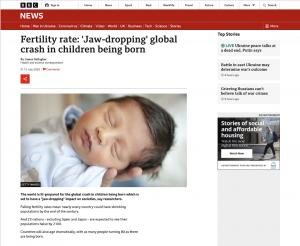
Declining Fertility Rates as a Function of Increasing Women’s Empowerment
According to BBC News, the world is witnessing a ‘jaw-dropping’ global crash in children being born. The news article, by James Gallagher, reports that falling fertility rates have “nothing to do” with usual phenomena that come to mind when discussing fertility such as egg or sperm count. Instead, the decline is mainly attributed to the participation of women in the labor force and in pursuing their education. Thus, leading to women choosing to have fewer children.

During the 1960s, women were having 5.5 children in their lifetime, on average. On a global level, this figure has been declining and is reported to be around 2.64 in 2019 while the GDP has been increasing. According to experts, if the average fertility rate falls below 2.1, approximately, the size of the population will start to fall worldwide. We observe that countries with higher GDP have lower fertility rates. On a global level, as GDP and women empowerment/ involvement in the labor force increases, the fertility rate decreases.
Allocating resources to encourage families, namely women, to get more children might help mitigate the decline in fertility rates. We observe that countries that have higher fertility rates (mainly in Africa) have the highest percentage of self-employed females. This might be attributed to the fact that women, in general, find it difficult to balance a full-time job and having several children. Thus emphasizing the correlation between fertility rates and the participation of women in the labor force, since females find it easier to be self-employed when having children in comparison to having a 9 to 5 job.
The resources that might contribute to encouraging couples to start/ grow their family are the following:
- Passing laws that give parents enough/better maternity and paternity leaves.
- Passing laws that require employers to give better parenthood benefits in labor-force participation as a part of the employee benefits package.
- Passing laws that increase the investment of resources allocated to opening childcare facilities that have long opening hours.
- Passing laws that further develop/ strengthen the social security system.
Denmark has successfully managed to increase fertility rates according to an article published by Forbes: “Denmark, with its heavily subsidized, always-available daycare, generous parental leave shared by both parents, and a culture ordered around community and family life rather than work, hit the “sweet spot” of replacement-level fertility rates.” We observe an overall increasing trend in the fertility rate from 1983 till 2020. Even though some years have witnessed a decline in child births during this time frame, the trend is overall increasing, especially in comparison to the birth rates from 1966 to 1983.
Denmark has proven that by allocating funds to invest in resources that facilitate finding a balance between having a family/ raising children and simultaneously participating in the labor force or pursuing degrees of higher education, fertility rates will improve.